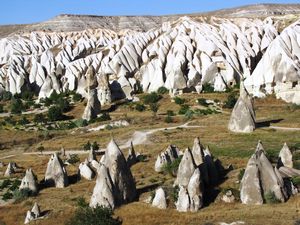Advertisement
Published: January 13th 2012

 Cappadocia
Cappadocia
Even without the carved houses and churches, the natural scenery of Cappadocia is breathtaking.I’m not trying to be rude; the title of this blog is my advice for anyone visiting Cappadocia. The open air museum at Goreme is good, but much more fun is to be had while exploring the surrounding valleys devoid of signboards, protective handrails, coach parties and entrance fees.
We decided to stay in Goreme. Much literature tells how Goreme has now lost all of its charm, giving itself over completely to tourism. Whatever. We liked it. Yes there are lots of carpet shops, balloon flight agencies and endless guesthouses, but it is also right in the centre of some of the most spectacular scenery I’ve ever seen.
Every day we set off in a different direction armed with a tiny hand-drawn map and lots of water. Red Valley, Pigeon Valley, Swords Valley, Rose Valley, Penis Valley (or the Valley of Love as they, more romantically but less illustratively, prefer to call it), White Valley, we saw them all and would recommend them all. Often the highlights are the bits in between, not labeled on our map, that see less tourists. We explored tiny rock-cut churches with intricately carved and painted interiors and dwellings dug

 Cappadocia
Cappadocia
Lots of these in the conservatively, or maybe romantically named, Valley of Love.out high in the cliffs then enjoyed fresh orange and pomegranate juice from cafes that miraculously appear in caves just when you are flagging from thirst.
I first heard of Cappadocia in A-Level Geology classes at school. We must have been learning something about weathering and erosion and saw pictures of huge black boulders precariously balancing on high white pinnacles. At the time I learnt that the boulders are volcanic basalt bombs ejected from a volcano which then landed on the white ash. Over time the ash lithified into tuff but was still much less resistant to weathering and erosion than the basalt. Thus the small area beneath the basalt bomb was protected while all around has gradually worn and washed away leaving narrow towers with their distinctive boulder cap. However, I now know, after visiting Cappadocia, that they were built by fairies.
A great side-trip was to Derinkuyu’s underground city. Getting there and back was pleasant too on little local buses - much more interesting than the big overnight coaches we had used so far in Turkey. The city was first dug out by the Phrygians around 800BC and was later used by

 Derinkuyu, one of Cappadocia's underground cities
Derinkuyu, one of Cappadocia's underground cities
Later used by Christians to escape Roman persecution but first dug around 800BC by Phrygians. The rooms and passages go down 85 metres and it housed 50,000 peopleearly Christians to escape Roman persecution. I expected a few interconnected caves but in fact it really is an underground city. It reaches depths of 85m and housed over 50000 people. Huge circular stone doors lay at the entrance passages ready to be rolled across in times of peril. Wells and ventilation shafts could still provide air and water when the entrances were sealed off. There are carved chapels, wineries, stables and plumbing systems and it isn’t that busy that you can’t enjoy some parts of it alone and really get a feel for what it must have been like to live there.
The tourist board of Cappadocia has Mount Erciyes to thank for providing vast amounts of easily carved tuff that erupted as ash around 2 million years ago. The volcano is always visible on the horizon and must look down proudly at what it has created. Even without the fantastic man-made features the landscape alone is breathtaking, looking as though it itself has been carved by a greater hand.
The heat and dust combine to draw all of the moisture out of your body when exploring so we splashed out, paying only

 Capppadocia
Capppadocia
Another ancient cave to explore up ahead. This one was one of my favourites.about £5 extra a night, for a guesthouse with a pool. It was great to get back after a day’s trekking and jump straight in. Plus we usually had it to ourselves.
In an evening there is a huge choice of restaurants, the more expensive ones, as with the more expensive hotels, being built into the strange rock formations within town. The trick though, as with the rest of Turkey and indeed with all of the world, is to decline the not too hard sell tactics of the waiters and managers as you pass by their restaurants and head into the side streets and alleyways to eat where the locals do. As well as getting top food for bargain prices, we were often given free desserts or tea just for being the only foreigners there.
I had an idea before the Turkey leg of this trip that Cappadocia would be a highlight for me. It certainly didn’t disappoint.
Advertisement
Tot: 0.094s; Tpl: 0.016s; cc: 14; qc: 34; dbt: 0.0589s; 1; m:domysql w:travelblog (10.17.0.13); sld: 1;
; mem: 1.1mb

 Cappadocia
Cappadocia
 Cappadocia
Cappadocia
 Derinkuyu, one of Cappadocia's underground cities
Derinkuyu, one of Cappadocia's underground cities
 Capppadocia
Capppadocia
















